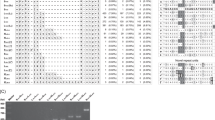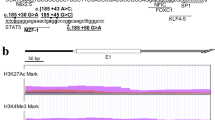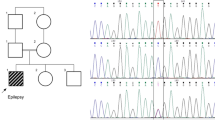Abstract
The synaptic vesicular monoamine transporter (SVMT), alternatively vesicular monoamine transporter 2 (VMAT2), pumps cytosolic monoamines including dopamine, norepinephrine, serotonin, and histamine into synaptic vesicles. Altered functions of SVMT have been implicated in the pathogensis of several neuropsychiatric diseases. We determined exon/intron boundaries of the human SVMT gene and performed mutational analysis for the exonic and neighboring intronic regions of the gene. Detected polymorphisms were subject to association analysis with schizophrenia in a family-based design. The human SVMT gene consists, of 16 exons and 15 introns, which is consistent with the murine SVMT gene. When mutational analysis was performed by the single strand conformational polymorphism (SSCP) analysis, we found two and four single nucleotide polymorphisms (SNPs) in exons and neighboring introns, respectively. Neither exonic SNP results in an amino acid change. In family-based association analyses in a sample of 50 Japanese schizophrenics and their parents, no significant association was found for the intronic polymorphisms. Our data suggest that there is no common polymorphism in the SVMT gene affecting the primary structure of the human SVMT protein. Furthermore, we obtained no evidence for the major effect of the novel polymorphisms on susceptibility to schizophrenia.
This is a preview of subscription content, access via your institution
Access options
Subscribe to this journal
Receive 12 print issues and online access
$259.00 per year
only $21.58 per issue
Buy this article
- Purchase on Springer Link
- Instant access to full article PDF
Prices may be subject to local taxes which are calculated during checkout

Similar content being viewed by others
References
Iversen LL . Catecholamine uptake processes Br Med Bull 1973 29: 130–135
Edwards RH . The transport of neurotransmitters into synaptic vesicles Curr Opin Neurobiol 1992 2: 586–594
Masson J, Sagn C, Hamon M, Mestikawy SE . Neurotransmitter transporters in the central nervous system Pharmacol Rev 1999 51: 439–464
Williams J . How does a vesicle know it is full? Neuron 1997 18: 683–686
Frize E . Mental depression in hypertensive patients treated for long periods with high doses of reserpine N Engl J Med 1954 251: 1006–1008
Sulzer D, Chen TK, Lau YY, Kristensen H, Rayport S, Ewing A . Amphetamine redistributes dopamine from synaptic vesicles to the cytosol and promotes reverse transport J Neurosci 1995 15: 4102–4108
Russo SM, Daniels AJ, Viveros OH, Reinhard JF Jr . Differences in the reserpine-sensitive storage in vivo of 1-methyl-4-phenylpyridinium in rats and mice may explain differences in catecholamine toxicity to 1-methyl-4-phenyl-1,2,3,6-tetrahydropyridine Neurotoxicol Teratol 1994 16: 277–281
Zuddas A, Fascetti F, Corsini GU, Piccardi MP . In brown Norway rats, MPP+ is accumulated in the nigrostriatal dopaminergic terminals but it is not neurotoxic: a model of natural resistance to MPTP toxicity Exp Neurol 1994 127: 54–61
Takahashi N, Miner LL, Sora I, Ujike H, Revay RS, Kostic V et al. VMAT2 knockout mice: heterozygotes display reduced amphetamine-conditioned reward, enhanced amphetamine locomotion, and enhanced MPTP toxicity Proc Natl Acad Sci USA 1997 94: 9938–9943
Wang YM, Gainetdinov RR, Fumagalli F, Xu F, Jones SR, Bock CB et al. Knockout of the vesicular monoamine transporter 2 gene results in neonatal death and supersensitivity to cocaine and amphetamine Neuron 1997 19: 1285–1296
Liu Y, Peter D, Roghani A, Schuldiner S, Prive GG, Eisenberg D et al. A cDNA that suppresses MPP+ toxicity encodes a vesicular amine transporter Cell 1992 70: 539–551
Erickson JD, Eiden LE, Hoffman BJ . Expression cloning of a reserpine-sensitive vesicular monoamine transporter Proc Natl Acad Sci USA 1992 89: 10993–10997
Surratt CK, Persico AM, Yang X-D, Edgar SR, Bird GS, Hawkins AL et al. A human synaptic vesicle monoamine transporter cDNA predicts posttranslational modifications, reveals chromosome 10 gene localization and identifies TaqI RFLPs FEBS Lett 1993 318: 325–330
Peter D, Finn JP, Klisak I, Liu Y, Kojis T, Heinzmann C et al. Chromosomal localization of the human vesicular amine transporter genes Genomics 1993 18: 720–723
Takahashi N, Uhl G . Murine vesicular monoamine transporter 2: molecular cloning and genomic structure Brain Res Mol Brain Res 1997 49: 7–14
Persico AM, Wang ZW, Black DW, Andreasen NC, Uhl GR, Crowe RR . Exclusion of close linkage between the synaptic vesicular monoamine transporter locus and schizophrenia spectrum disorders Am J Med Genet 1995 60: 563–565
Risch N, Merikangas K . The future of genetic studies of complex human diseases Science 1996 273: 1516–1517
American Psychiatric Association . Diagnostic and Statistical Manual of Mental Disorders, 4th edn American Psychiatric Association: Washington DC 1994
Terwilliger JD, Ott J . A haplotype-based ‘haplotype relative risk’ approach to detecting allelic associations Hum Hered 1992 42: 337–346
Acknowledgements
We thank Ms A Kondo and N Okuyama for their help in the laboratory. This study was supported by Ministry of Health and Welfare, Japan.
Author information
Authors and Affiliations
Corresponding author
Rights and permissions
About this article
Cite this article
Kunugi, H., Ishida, S., Akahane, A. et al. Exon/intron boundaries, novel polymorphisms, and association analysis with schizophrenia of the human synaptic vesicle monoamine transporter (SVMT) gene. Mol Psychiatry 6, 456–460 (2001). https://doi.org/10.1038/sj.mp.4000895
Received:
Revised:
Accepted:
Published:
Issue Date:
DOI: https://doi.org/10.1038/sj.mp.4000895
Keywords
This article is cited by
-
Association study of the vesicular monoamine transporter 1 (VMAT1) gene with schizophrenia in a Japanese population
Behavioral and Brain Functions (2006)



